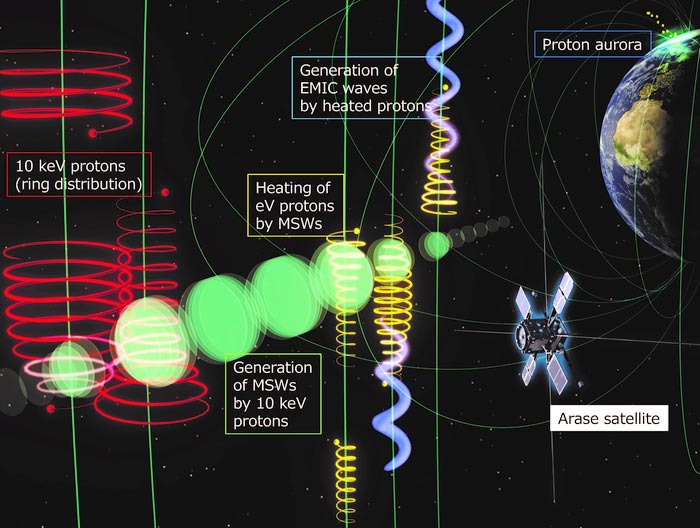Arase satellite uncovers coupling between plasma waves and charged particles in Geospace

Hot ions (red) generate magnetosonic waves (MSWs; green), which then propagate across the field lines and heat up cold ions (yellow) by transferring their energy to them. A part of this transferred energy goes into generating EMIC waves (blue).
Credit: © ERG Science Team
Scientists unravel a bit more of the mystery underlying how wave-particle interactions generate other plasma waves in Geospace.
In a new study published in Physical Review Letters, researchers from Japan show that high-frequency plasma waves in the Geospace can generate low-frequency plasma waves through wave-particle interactions by heating up low-energy ions, unveiling a new energy transfer pathway in collisionless plasma.
A prominent signature of plasma — a state of matter characterized by freely roaming charged particles interacting via electromagnetic forces — is the generation of “plasma waves,” resulting from an instability of plasma distributions. “Fast magnetosonic waves” (MSWs) are one kind of electromagnetic plasma wave in the Geospace. MSWs result from hot protons and are considered “high frequency waves.”
Another kind of wave commonly generated in the Geospace is the “electromagnetic ion cyclotron” (EMIC) wave, which is considered a “low frequency wave.” Recently, satellite observations in the Geospace have shown that MSWs and EMIC waves often occur together. However, the mechanism underlying this co-occurrence has remained unclear.
Now, a team of researchers led by Professor Yoshizumi Miyoshi from Nagoya University, Japan, has somewhat unraveled this mechanism. “MSWs are known to occur together with the heating of low-energy protons and studies have shown that MSWs can heat up these ‘cold’ ions. With the recent observation data by the Arase satellite showing simultaneous EMIC waves, we wondered whether the appearance of EMIC waves is actually coupled with the MSW-mediated ion heating process,” says Prof. Miyoshi, explaining the motivation behind the study.
Accordingly, the team applied a wave-particle interaction analysis method to the MSWs and EMIC waves — which they observed with the Arase satellite — to examine the “cross-energy coupling” between them through ion heating. The results were enlightening: they found that while MSWs transferred energy to the “cold” protons to heat them up, a part of the transferred energy of protons went into exciting the EMIC waves. Considering that MSWs were, in turn, excited by hot protons, they, in fact, acted as a mediating agent for energy transfer to the EMIC waves, i.e., a cross-energy coupling between hot protons, cold protons, MSWs, and EMIC waves.
While these findings are exciting in themselves, Prof. Miyoshi explains how they are of significance to our knowledge about the Geospace as well: “EMIC waves cause significant scattering and loss of ‘killer electrons’ in the Van Allen radiation belts which often cause satellite malfunctions. The new energy transfer route for exciting EMIC waves revealed in our study could contribute to improved space weather forecasting, making for safer operations of satellite in the Van Allen radiation belts.”
Perhaps more such interesting phenomena are waiting to be discovered amidst the riches of the Geospace!
The paper, “Cross-Energy Couplings from Magnetosonic Waves to Electromagnetic Ion Cyclotron Waves through Cold Ion Heating inside the Plasmasphere,” was published in the journal Physical Review Letters on December 10, 2021, at DOI: 10.1103/PhysRevLett.127.245101.
Authors:
Kazushi Asamura, Masafumi Shoji, Yoshizumi Miyoshi, Yoshiya Kasahara, Yasumasa Kasaba,
Atsushi Kumamoto, Fuminori Tsuchiya, Shoya Matsuda, Ayako Matsuoka, Mariko Teramoto,
Yoichi Kazama, and Iku Shinohara
Funding Information:
This work was supported by the Japan Society for the Promotion of Science (JSPS), KAKENHI Grants
No. 17H06140, No. 20H01959, No. 20K14546 and No. 21H04526.
About Nagoya University, Japan
Nagoya University has a history of about 150 years, with its roots in a temporary medical school and hospital established in 1871, and was formally instituted as the last Imperial University of Japan in 1939. Although modest in size compared to the largest universities in Japan, Nagoya University has been pursuing excellence since its founding. Six of the 18 Japanese Nobel Prize-winners since 2000 did all or part of their Nobel Prize-winning work at Nagoya University: four in Physics – Toshihide Maskawa and Makoto Kobayashi in 2008, and Isamu Akasaki and Hiroshi Amano in 2014; and two in Chemistry – Ryoji Noyori in 2001 and Osamu Shimomura in 2008. In mathematics, Shigefumi Mori did his Fields Medal-winning work at the University. A number of other important discoveries have also been made at the University, including the Okazaki DNA Fragments by Reiji and Tsuneko Okazaki in the 1960s; and depletion forces by Sho Asakura and Fumio Oosawa in 1954.
Website: https://en.nagoya-u.ac.jp/
Journal: Physical Review Letters
DOI: 10.1103/PhysRevLett.127.245101
Method of Research: Observational study
Subject of Research: Not applicable
Article Title: Cross-Energy Couplings from Magnetosonic Waves to Electromagnetic Ion Cyclotron Waves through Cold Ion Heating inside the Plasmasphere
Article Publication Date: 10-Dec-2021
All latest news from the category: Physics and Astronomy
This area deals with the fundamental laws and building blocks of nature and how they interact, the properties and the behavior of matter, and research into space and time and their structures.
innovations-report provides in-depth reports and articles on subjects such as astrophysics, laser technologies, nuclear, quantum, particle and solid-state physics, nanotechnologies, planetary research and findings (Mars, Venus) and developments related to the Hubble Telescope.
Newest articles
Faster, more energy-efficient way to manufacture an industrially important chemical
Zirconium combined with silicon nitride enhances the conversion of propane — present in natural gas — needed to create in-demand plastic, polypropylene. Polypropylene is a common type of plastic found…

Energy planning in Ghana as a role model for the world
Improving the resilience of energy systems in the Global South. What criteria should we use to better plan for resilient energy systems? How do socio-economic, technical and climate change related…

Artificial blood vessels could improve heart bypass outcomes
Artificial blood vessels could improve heart bypass outcomes. 3D-printed blood vessels, which closely mimic the properties of human veins, could transform the treatment of cardiovascular diseases. Strong, flexible, gel-like tubes…





















